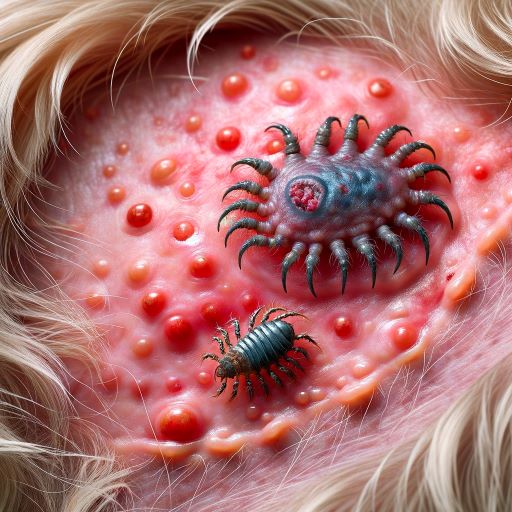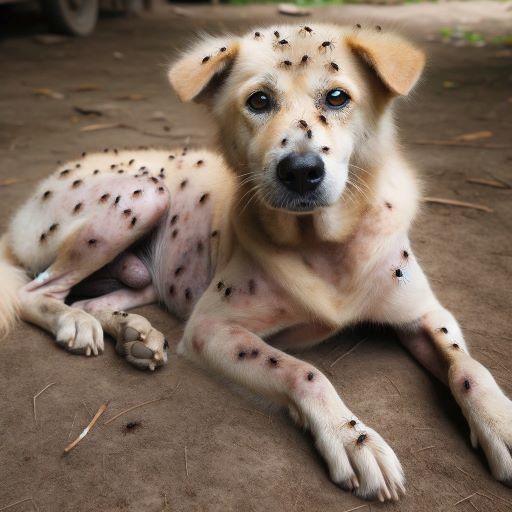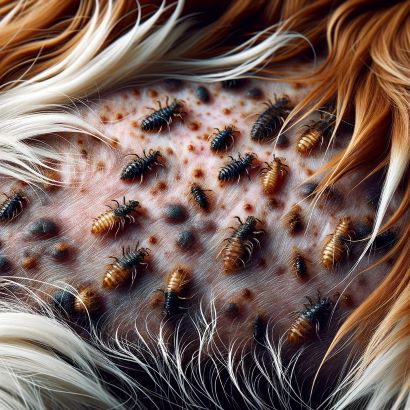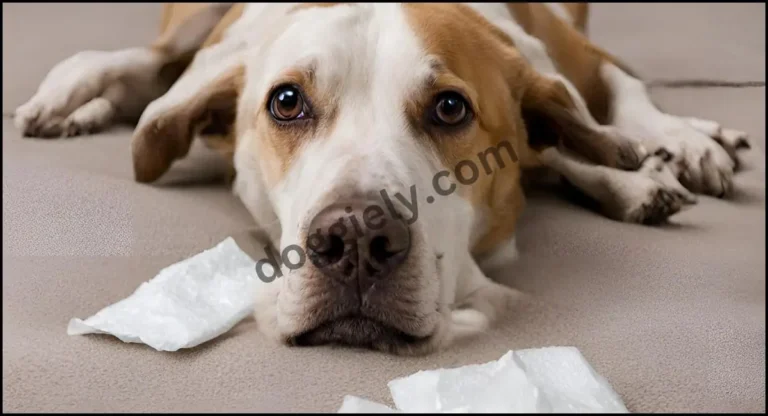where can dogs get lice? best answer revealed

As a Dog owner you might be wondering about the various health concerns that could your pets, one of the common questions being asked is, “Where can dogs get lice?” This article aims to inform dog owners about the risks, environments, and circumstances under which dogs can contract lice, emphasizing prevention and management strategies.
Understanding the environments and situations that facilitate the spread of these parasites is crucial for preventing infestation and ensuring the health of our canine friends.
Myths and Misunderstandings
It’s a myth that only dirty or neglected dogs can get lice. Lice can infest dogs of all breeds, ages, and living conditions. Additionally, dog lice cannot live on humans, so while they may cause discomfort to your pet, they don’t pose a direct risk to human health.
Understanding Dog Lice
Before diving into where dogs can get lice, it’s important to understand what we’re dealing with. Dog lice are tiny, wingless parasites that live on the skin and fur of dogs. They are species-specific, meaning they do not transfer between dogs and humans. There are two types of dog lice: one that feeds on blood (Linognathus setosus) and another that feeds on dead skin (Trichodectes canis). Both can cause intense itching, skin irritation, and in severe cases, anemia.
Where Can Dogs Get Lice?
Identifying the environments and situations where dogs can get lice is key to preventing infestation. Here are the most common scenarios:
- Direct Contact with Infested Dogs: The primary mode of lice transmission is through direct contact. Dogs playing, cuddling, or otherwise coming into close contact with an infested dog can easily pick up lice.
- Shared Bedding or Grooming Tools: Dogs can get lice by sharing bedding, brushes, and other grooming tools with an infested dog. Lice can survive for a short period away from the host, making transmission possible through these items.
- Visits to Dog Parks and Kennels: Places where dogs congregate, such as dog parks, kennels, and daycare centers, can be hotspots for lice transmission. The close quarters and high level of interaction facilitate the spread of these parasites.
- Veterinary Clinics and Grooming Salons: Although professionals in these establishments take measures to prevent cross-contamination, there’s still a slight risk. An infested dog can leave lice or nits (lice eggs) behind, which can then attach to another dog.
- The Great Outdoors: While lice are less likely to be contracted from the environment compared to fleas and ticks, infested animals in the surroundings can be a source of lice for pet dogs.
Preventing Lice Infestation
Understanding where dogs can get lice is the first step in prevention. Here are effective strategies to minimize the risk:
- Regular Grooming and Inspection: Frequent grooming and inspection of your dog’s coat and skin can help catch and remove lice early before they become a bigger problem.
- Maintain a Clean Environment: Regularly wash and disinfect your dog’s bedding, toys, and grooming tools. This helps eliminate any lice or eggs that might be present.
- Avoid Direct Contact with Infested Dogs: When aware of an infestation, keep your dog away from the affected pet until they have been treated and cleared by a vet.
- Use Preventative Treatments: Consult with your veterinarian about preventative treatments that are effective against lice, especially if your dog frequents high-risk areas.
Treating Dog Lice
If your dog does get lice, prompt treatment is essential. Treatment typically involves:
- Topical Insecticides: Products prescribed by your veterinarian can effectively kill adult lice and their eggs.
- Environmental Decontamination: Along with treating your dog, clean and disinfect their environment to prevent re-infestation.
- Isolation: To prevent spreading to other pets, keep the infested dog isolated until they are lice-free.
Read Also: Why Does My Dog Lay His Head Over My Neck?
What does a lice infestation look like on a dog?

A lice infestation on a dog is not only uncomfortable for the animal but can also be concerning for the pet owner. Recognizing what a lice infestation looks like on a dog is crucial for timely intervention and treatment. Typically, a lice infestation can be identified by several key signs. The dog may exhibit excessive scratching, biting, or rubbing of the infested areas due to the irritation caused by lice bites. Upon closer inspection, one might notice tiny, sesame seed-sized insects moving in the dog’s fur or small white specks, which are lice eggs (nits) attached firmly to the hair shafts near the skin.
What does a lice infestation look like on a dog? Beyond the physical presence of lice and nits, affected dogs may show signs of skin redness, irritation, or even bald patches from severe scratching or biting. In some cases, a heavy lice infestation can lead to a dull coat and general unthriftiness due to the discomfort and stress it causes the animal. Identifying what a lice infestation looks like on a dog early on is key to managing and eliminating the problem effectively, ensuring the health and comfort of the pet. Regular grooming and health checks can help spot these signs early, leading to quicker treatment and relief for the dog.
Can dog lice live in carpet?
Dog lice, known scientifically as Trichodectes canis, are parasitic insects that commonly infest dogs’ fur and skin. However, many pet owners wonder, “Can dog lice live in carpet?” The answer is yes, dog lice can indeed survive in carpet fibers, especially if they have fallen off an infested dog and found their way into the carpeting.
When dogs with lice roam around the house, some lice may detach from their fur and land on carpets, rugs, or bedding. Once in the carpet, lice can survive for a period, waiting for another host to latch onto. Carpets provide an environment conducive to their survival, with fibers offering protection and potential hiding spots.
To prevent the spread of dog lice in your home, it’s essential to regularly clean and vacuum carpets and upholstery, paying extra attention to areas where your dog spends most of their time. Washing your dog’s bedding frequently can also help eliminate any potential lice hiding there.
If you suspect your dog has lice, it’s crucial to seek veterinary advice promptly. Additionally, treating your home with appropriate insecticides or seeking professional pest control services can help eradicate any lice lingering in your carpets, ensuring a lice-free environment for both you and your furry friend.
Read Also: How to Stop My Dog Barking When Out Walking?
Are dog lice harmful?
The short answer to “Are dog lice harmful?” is that while they may not be as dangerous as other parasites, they can cause significant discomfort and health issues for dogs. Infestations lead to intense itching and scratching, which can result in skin infections and hair loss. In severe cases, especially in young, old, or immunocompromised dogs, lice can contribute to anemia and overall poor condition due to their blood-feeding habits.
Therefore, appropriate preventive measures and treatments is essential. Regular grooming, maintaining a clean environment, and consulting with a veterinarian for lice prevention strategies can help protect dogs from the harmful effects of lice, ensuring they lead happy, healthy lives.
Can dog lice jump to humans?
When pet owners discover a lice infestation in their furry companions, a common concern arises: “Can dog lice jump to humans?” This question is especially pertinent for households where pets closely interact with family members. Understanding the nature of dog lice and their ability to infest humans is crucial for managing concerns and applying appropriate treatment measures.
Dog lice are species-specific parasites, meaning they are adapted to live on dogs and not humans. Therefore, the straightforward answer to the question, “Can dog lice jump to humans?” is no. These parasites have evolved to survive and thrive in the environment provided by a dog’s fur and skin, which differs significantly from that of human hair and skin.
Despite the close physical contact that may occur between pets and their owners, there is no risk of dog lice establishing an infestation in human hair. This distinction is essential for pet owners to understand, as it helps to alleviate concerns about personal infestation. However, while dog lice cannot jump to humans, maintaining good pet hygiene and promptly treating any lice infestations in pets is vital to ensure the health and comfort of both the dog and its human family members.
Read Also: sedating a dog for nail cutting

How do I get rid of dog lice in my house?
If you’re facing the pesky issue of dog lice infesting your home, you’re likely wondering, “How do I get rid of dog lice in my house?” Fortunately, there are several effective methods to tackle this problem and ensure a lice-free environment for both your furry friend and your household.
First and foremost, thorough cleaning is key. Start by vacuuming all carpets, rugs, and upholstery where your dog spends time. Pay close attention to crevices and corners where lice may hide. Additionally, wash your dog’s bedding, toys, and any other fabric items they come into contact with regularly in hot water to kill any lice and their eggs.
Next, consider treating your home with insecticides specifically formulated to target lice. Be sure to follow the instructions carefully and take precautions to protect yourself, your family, and your pets from exposure to harmful chemicals.
Another effective method is to enlist the help of professional pest control services. Pest control experts have the knowledge, experience, and tools to effectively eradicate lice infestations in your home safely and efficiently.
By combining thorough cleaning, targeted insecticide treatments, and professional assistance if needed, you can successfully eliminate dog lice from your house and create a healthier environment for everyone.
Conclusion
Knowing where dogs can get lice is pivotal in preventing these parasites from affecting your pet. By taking proactive steps to avoid high-risk situations, maintaining cleanliness, and implementing preventative measures, you can significantly reduce the chances of your dog contracting lice. Should your dog become infested, early detection and proper treatment will ensure a quick and complete recovery. Remember, a healthy dog is a happy dog, and understanding where dogs can get lice is an important part of responsible pet ownership.





